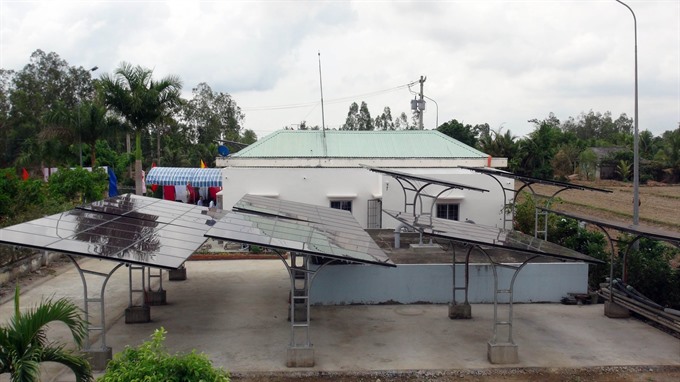 Society
Society

Investors have been looking for a synchronous policy to address difficulties faced in solar power projects in Việt Nam.
 |
| Solar cells at a water supply plant in An Phú Trung Commune, southern Bến Tre Province. In Việt Nam, solar energy is used modestly, just for households, water-boiling system, lighting and drying. — VNA/VNS Photo Trần Thị Thu Hiền |
HÀ NỘI — Investors have been looking for a synchronous policy to address difficulties faced in solar power projects in Việt Nam.
Chairman of Sơn Hà Group Lê Vĩnh Sơn said that investors were interested in solar power projects in Việt Nam but faced difficulties because of non-synchronous policies.
The difficulties included few legal frameworks, mechanisms and human resource for the production and application of renewable energy, he said.
Solar power projects usually required huge investment, resulting in high power costs which made solar power less competitive than other power types, he said.
Sơn said that solar power projects were costly but investors found it difficult to get loans, even preferential loans which are designed to encourage science and technology projects.
Chairman and General Director of Red Sun Energy Joint Stocks Company Diệp Bảo Cảnh said that so far, few credit institutions or banks had schemes to develop human resources for assessing and approving credit to solar power projects.
Dr Nguyễn Huy Hoạch from Việt Nam Clean Energy Associtaion said that Việt Nam had great potential for solar energy, particularly in the Central Highlands region and south central provinces with an average 2,000-2,600 hours of sunlight each year.
It has average solar irradiance of 4-5 kWh/squ.m/day, which is comparable to Thailand and the Philippines, which have more developed solar markets in the region.
However, in Việt Nam, solar energy was little used, just for households, water-boiling system, lighting and drying, he said.
Tăng Thế Hùng, vice head of Planning Division under General Directorate of Energy, said so far Việt Nam had no commercial solar power generating project despite the country wanting to increase solar power productivity from a few MW now to 850MW in 2020 and 4,000 MW in 2025.
Hùng said that two months ago, the Ministry of Industry and Trade submitted a proposal on solar power price to Prime Minister Nguyễn Xuân Phúc.
Under the proposal, the Government would subsidise VNĐ 3,150 (US$15 cents) per kWh to rooftop solar power projects. To other on-grid solar power projects, each kWh would be paid VNĐ 2,352 (11.2cents). The projects must have solar cells with efficiency higher than 16 per cent and productivity of less than 100 MW.
Until now, about 4MW of solar power is used in Việt Nam with few systems including the 200kWp system of Intel in HCM City Hi-tech Zone, a 140 kWp system in Tân Tạo Industrial Zone and a 212 kWP system on the rooftop parking area of Big C supermarket in southern Bình Dương Province.
Previously, the ministry proposed Electricity of Việt Nam (EVN) buy solar power at 11.2 cent per kWh but investors said the price was too low, being lower than the price that the EVN buys electricity from small hydro power plants during rush hours – 12.38 cent.
The United Nations Development Programme, in its report in May, 2016, suggested regulating a “Feed-in-Tariff” of 15 USD cents/ kWh for mainland solar photovoltaic (PV)power plants, and 19 USD cents/ kWh for power plants on islands, over a period of 20 years.
The organisation also recommended financial support for-grid and off-grid solar PV systems in remote areas and islands as well as incentives to reduce investment costs of solar PV power plants, “rooftop” and community solar PV systems.
Dr Dương Duy Hoạt from the Institute of Energy Science, said a law on renewable energy is needed to ensure sustainable development of renewable energy.
The Government needs to instruct ministries, sectors and localities to plan for developing renewable energy on the basis of forecasts of demand and supply.
Developing national criteria and regulations on renewable energy is also necessary, Hoat said, adding that a fund should be established to ensure financial resources for renewable energy research and development.
Incentives should be offered to encourage international and domestic enterprises to participate in the sector, while promoting communications to raise public awareness of value of renewable energy in sustainable development, according to Hoat.
The revised Việt Nam Power Development Planning in the period 2011-2020 with an outlook to 2030, approved by the Prime Minister in March, 2016, has given priority to developing renewable energy sources, step by step raising the share of renewable energy in national electricity output to 7 per cent in 2020 and over 10 per cent by 2030.
Total hydropower capacity is expected to reach 21,600 MW by 2020 from the current 17,000 MW, and to 24,600 MW and 27,800 MW by 2025 and 2030, respectively. The hydropower output will account for 29.5 per cent, 20.5 per cent and 15.5 per cent of total electricity generation in 2020, 2025 and 2030, respectively.
The planning also aims to raise wind energy capacity from 140 MW now to 800 MW by 2020, accounting for 0.8 per cent of total electricity output.
— VNS




